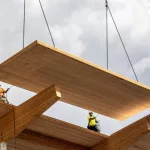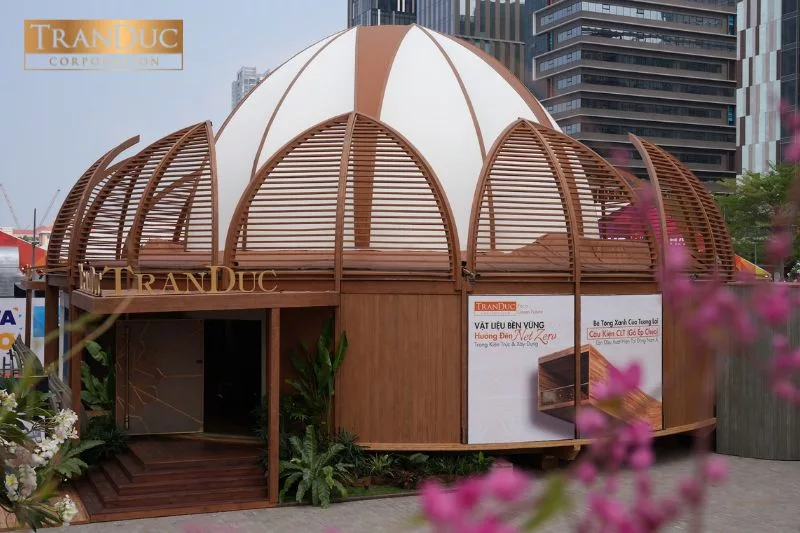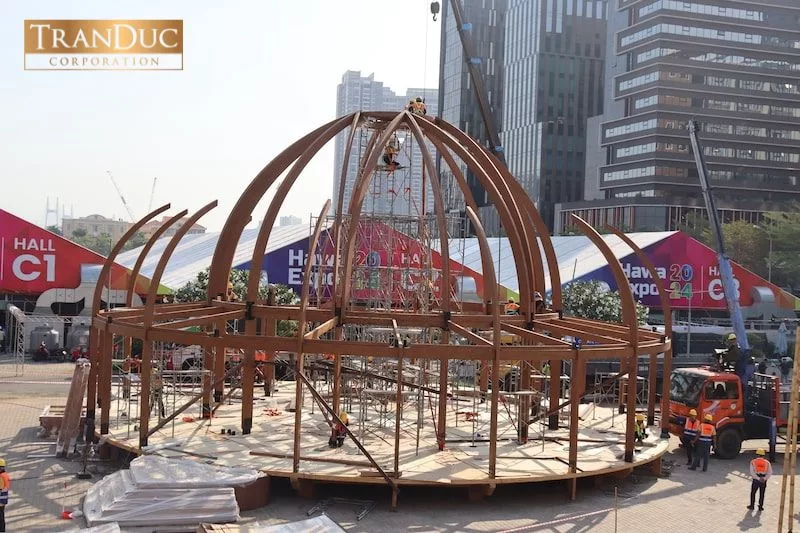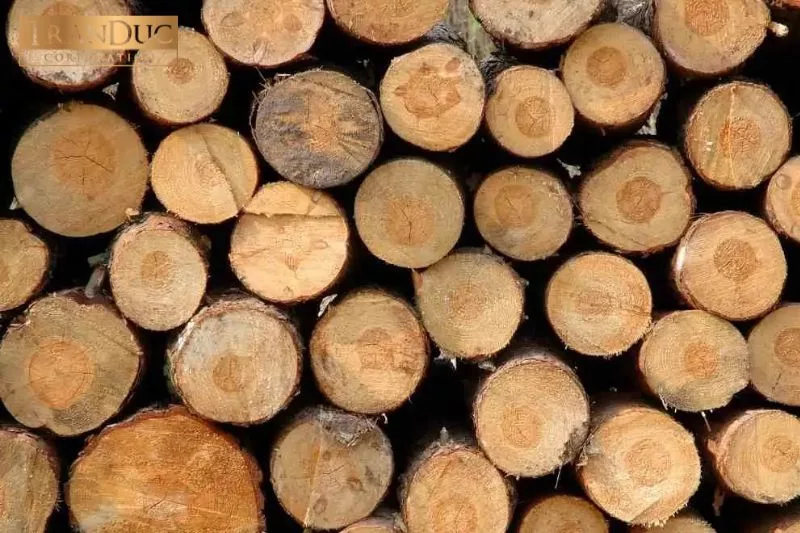

In the construction sector, wood components not only play a crucial role in completing Green projects but also ensure structural integrity, safety, and aesthetics. From utilizing renewable resources to minimizing construction waste, wood components are not just a technical solution but also a symbol of commitment to a green future.
Join us as we delve deeper into wood components, their applications, and the potential they offer for sustainable architecture and construction in the article below.

The TranDuc’s over 400m2 booth at the HAWA 2024 Fair is entirely made from engineered wood components.
Engineered wood components are a type of building material made by joining pieces of wood together, with a high load-bearing structure, providing durability and safety for constructions. Commonly used in Green projects, engineered wood components not only require high aesthetic appeal but also ensure superior load-bearing capacity. This is also considered a potential solution to completely replace concrete in the future.

Engineered wood components have a high load-bearing structure, providing durability and safety for constructions.
Currently, in architecture and Green construction, two types of engineered wood components are commonly used: CLT (Cross-Laminated Timber) and Glulam (Glued Laminated Timber).
With high load-bearing capacity, Glulam components are often used for beams, columns, purlins, and girders. Meanwhile, CLT is used for items such as floors, ceilings, and walls. Both types of engineered wood components play an important role in creating modern constructions with durability, safety, and high aesthetics.
 Glulam beams and CLT components being installed at a project manufactured, constructed, and completed by TranDuc.
Glulam beams and CLT components being installed at a project manufactured, constructed, and completed by TranDuc.
With the current global climate change situation, finding sustainable building solutions is a top priority. Among green building solutions, engineered wood components have emerged as an excellent choice, not only for the natural beauty of wood but also for the benefits it brings to the environment and society.
One of the main reasons is the recyclability of wood. Wood is a renewable resource, which can be grown and harvested sustainably. Using wood from planned, sustainably sourced plantations helps reduce pressure on natural forests and maintain ecological balance.
In addition, engineered wood components also provide good mechanical properties, keeping constructions durable and stable. The flexibility in designing and processing wood is also a major advantage, helping to optimize the construction process, increase durability, and reduce wood resource waste.
Inspections from the Ministry of Construction show that cement accounts for the largest proportion of emissions. Therefore, to achieve the Net Zero goal, switching to alternative solutions such as engineered wood components is essential to reduce negative environmental impacts compared to other building materials such as steel or concrete. In addition, the production and processing of engineered wood components at the factory reduces construction time on site, thus consuming less energy than other materials, helping to reduce harmful emissions to the environment.
 Engineered wood components made from sustainably harvested wood help protect the environment.
Engineered wood components made from sustainably harvested wood help protect the environment.
In the future, engineered wood will play an increasingly important role in architecture and construction. The development of technology and awareness of environmental protection have driven the transition from traditional materials such as iron, steel, and concrete to wood, due to its outstanding advantages in sustainability and flexible design.
With the development of wood production and processing technology, engineered wood components in the future can be created with high precision and good load-bearing capacity, opening up many creative opportunities in architectural design.
A notable trend in the future is the combination of wood with other materials, such as iron and steel, to create strong and diverse structural components. This combination not only enhances design flexibility but also improves the performance and durability of constructions.
 Using sustainable wood in construction helps reduce emissions, towards the Net Zero goal.
Using sustainable wood in construction helps reduce emissions, towards the Net Zero goal.
Engineered wood components are an undeniable solution for green buildings in the context of increasing environmental and sustainability challenges. The use and development of engineered wood components bring benefits in terms of sustainability and open up new opportunities in design and construction.
At the same time, advances in technology and awareness of environmental protection will continue to promote the development of engineered wood components, contributing to building a green, clean, and sustainable future. TranDuc Homes, a member of the TranDuc Corporation, is a pioneer in the production, supply, and application of engineered wood components in Southeast Asia.
Contact us for more details
With over 20 years of experience, TranDuc Homes proudly stands as the leading provider of comprehensive solutions for the Architecture and Construction sectors in Southeast Asia. TranDuc Homes is aiming for a future where our solutions not only lead in quality but also pioneer the development of green construction, sustainable living, and environmental protection.
HCM Office:
Unit 901, The Waterfront Saigon, 1-1A-2 Ton Duc Thang, Sai Gon Ward, Ho Chi Minh City, Vietnam.
Factory:
69/13 Binh Chuan 42 Street, Binh Phuoc A Quarter, An Phu Ward, Ho Chi Minh City, Vietnam.
E-Mail: [email protected]
Phone: 0988 897 997